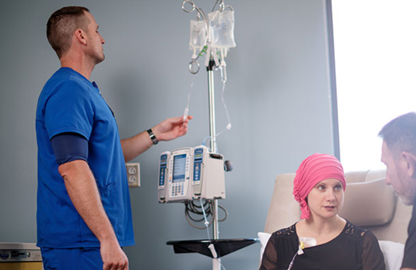
Hodgkin’s lymphoma is a type of cancer that affects the lymphatic system, which is a part of the body’s germ-fighting immune system.
Signs and symptoms of Hodgkin’s lymphoma may include:
- Painless swelling of lymph nodes in your neck, armpits or groin
- Persistent fatigue
- Fever
- Night sweats
- Losing weight without trying
- Severe itching
- Pain in your lymph nodes after drinking alcohol
There are multiple types of Hodgkin’s lymphoma. Your type is based on the characteristics of the cells involved in the disease and their behavior. The type of lymphoma you have helps determines your treatment options. Factors that can increase the risk of Hodgkin’s lymphoma include:
- Your age.Hodgkin’s lymphoma is most often diagnosed in people in their 20s and 30s and those over age 55.
- A family history of lymphoma.Having a blood relative with Hodgkin’s lymphoma increases your risk of developing it.
- Being male.People who are assigned male at birth are slightly more likely to develop Hodgkin’s lymphoma than are those who are assigned female.
- Past Epstein-Barr infection.People who have had illnesses caused by the Epstein-Barr virus, such as infectious mononucleosis, are more likely to develop Hodgkin’s lymphoma than people who haven’t had Epstein-Barr infections.
- HIV infection.People who are infected with HIV have an increased risk of Hodgkin’s lymphoma.


There are multiple types of Hodgkin’s lymphoma. Your type is based on the characteristics of the cells involved in the disease and their behavior. The type of lymphoma you have helps determines your treatment options. Factors that can increase the risk of Hodgkin’s lymphoma include:
- Your age.Hodgkin’s lymphoma is most often diagnosed in people in their 20s and 30s and those over age 55.
- A family history of lymphoma.Having a blood relative with Hodgkin’s lymphoma increases your risk of developing it.
- Being male.People who are assigned male at birth are slightly more likely to develop Hodgkin’s lymphoma than are those who are assigned female.
- Past Epstein-Barr infection.People who have had illnesses caused by the Epstein-Barr virus, such as infectious mononucleosis, are more likely to develop Hodgkin’s lymphoma than people who haven’t had Epstein-Barr infections.
- HIV infection.People who are infected with HIV have an increased risk of Hodgkin’s lymphoma.
WE, AT ART OF HEALING CANCER, ARE EXPERTS IN MAKING HIGHLY ACCURATE DIAGNOSES ON THE BASIS OF PERIPHERAL SMEAR EXAMINATION AND BONE MARROW FINDINGS
Hodgkin’s lymphoma stages
The health care team uses the results of the tests to assign Hodgkin’s lymphoma a stage. Assigning a stage is helpful in understanding the seriousness of your condition and determining which treatments are most likely to help you.
Hodgkin’s lymphoma staging uses the numbers 1 to 4 to indicate the stage. A lower number indicates an early stage cancer that’s more likely to be cured. A higher number means the cancer is more advanced.
Sometimes, Hodgkin’s lymphoma stages also include the letters A and B. The letter A means that you don’t have worrying symptoms of cancer. The letter B means that you have some signs and symptoms, such as a persistent fever, unexplained weight loss, and night sweats.


Treatment
The goal of Hodgkin’s lymphoma treatment is to destroy as many of the lymphoma cells as possible and bring the disease into remission. Which treatments are right for you depends on the type and stage of the cancer and your overall health and preferences. Various treatment modalities used in the Hodgkin’s lymphoma treatment are as follows:
Chemotherapy
Chemotherapy is a drug treatment that uses chemicals to kill lymphoma cells. Chemotherapy drugs travel through your bloodstream and can reach nearly all areas of your body. Chemotherapy drugs can be taken in the form of a pill or through a vein in the arm. Sometimes, both methods of administration are used.

THE EXPERTS AT ART OF HEALING CANCER ARE HIGHLY SPECIALIZED IN DIAGNOSING EVERY MPN SUBTYPE. WE WELCOME THE OPPORTUNITY TO PROVIDE SECOND OPINIONS FOR MPN.

Radiation Therapy
Radiation therapy uses high-energy beams, such as X-rays and protons, to kill cancer cells. During radiation therapy, you lie on a table and a large machine moves around you, directing the energy beams to specific points on your body.
Bone Marrow Transpalnt
Bone marrow transplant, also known as stem cell transplant, is a treatment to replace your diseased bone marrow with healthy stem cells that help you grow new bone marrow. A bone marrow transplant may be an option if Hodgkin’s lymphoma returns or doesn’t respond to other treatments.

Other Drug Therapies
